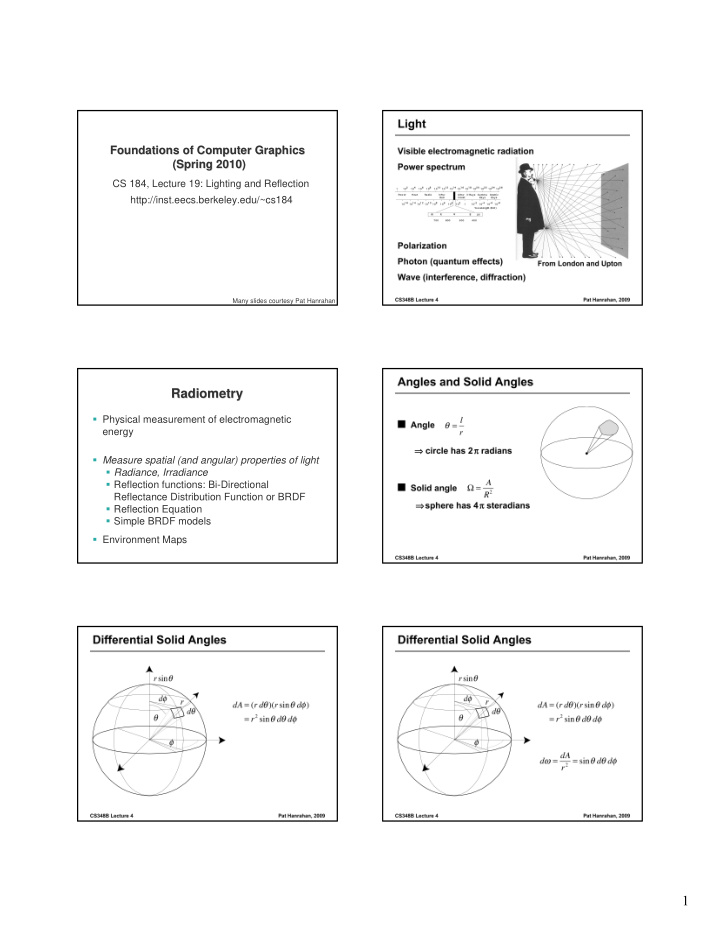



Foundations of Computer Graphics Foundations of Computer Graphics (Spring 2010) (Spring 2010) CS 184, Lecture 19: Lighting and Reflection http://inst.eecs.berkeley.edu/~cs184 Many slides courtesy Pat Hanrahan Radiometry Radiometry Physical measurement of electromagnetic energy Measure spatial (and angular) properties of light Radiance, Irradiance Reflection functions: Bi-Directional Reflectance Distribution Function or BRDF Reflection Equation Simple BRDF models Environment Maps 1
Radiance • Power per unit projected area perpendicular to the ray per unit solid angle in the direction of the ray • Symbol: L(x, ω ) (W/m 2 sr) • Flux given by d Φ = L(x, ω ) cos θ d ω dA Radiance properties • Radiance constant as propagates along ray – Derived from conservation of flux – Fundamental in Light Transport. d L d dA L d dA d 1 1 1 2 2 2 1 2 2 2 d dA r d dA r 1 2 2 1 dA dA 1 2 d dA d dA 1 1 2 2 2 r L L 1 2 Radiance properties • Sensor response proportional to radiance (constant of proportionality is throughput) – Far away surface: See more, but subtends smaller angle – Wall equally bright across viewing distances Consequences – Radiance associated with rays in a ray tracer – Other radiometric quants derived from radiance 2
Irradiance, Radiosity • Irradiance E is radiant power per unit area • Integrate incoming radiance over hemisphere – Projected solid angle (cos θ d ω ) – Uniform illumination: Irradiance = π [CW 24,25] – Units: W/m 2 • Radiant Exitance (radiosity) – Power per unit area leaving surface (like irradiance) Irradiance Environment Maps Irradiance Environment Maps R N Incident Radiance Irradiance Environment Map (Illumination Environment Map) 3
Radiometry Radiometry Physical measurement of electromagnetic energy Measure spatial (and angular) properties of light Radiance, Irradiance Reflection functions: Bi-Directional Reflectance Distribution Function or BRDF Reflection Equation Simple BRDF models Environment Maps Building up the BRDF • Bi-Directional Reflectance Distribution Function [Nicodemus 77] • Function based on incident, view direction • Relates incoming light energy to outgoing • Unifying framework for many materials 4
BRDF • Reflected Radiance proportional Irradiance • Constant proportionality: BRDF • Ratio of outgoing light (radiance) to incoming light (irradiance) – Bidirectional Reflection Distribution Function – (4 Vars) units 1/sr ( ) L r r ( , ) f i r ( )cos L d i i i i ( ) ( ) ( , )cos L L f d r r i i i r i i Isotropic vs vs Anisotropic Anisotropic Isotropic Isotropic: Most materials (you can rotate about normal without changing reflections) Anisotropic: brushed metal etc. preferred tangential direction Anisotropic Isotropic Reflection Equation i r ( ) ( ) ( , )( ) L L f n r r i i i r i Incident BRDF Cosine of Reflected Radiance (Output Image) radiance (from Incident angle light source) 5
Reflection Equation Reflection Equation d i i r i r Sum over all light sources Replace sum with integral ( ) ( ) ( , )( ) ( ) ( ) ( , )( ) L L f n L L f n d r r i i i r i r r i i i r i i i Reflected Radiance Incident BRDF Cosine of Reflected Radiance Incident BRDF Cosine of (Output Image) radiance (from Incident angle (Output Image) radiance (from Incident angle light source) light source) Radiometry Brdf Viewer plots Viewer plots Radiometry Brdf Physical measurement of electromagnetic energy Measure spatial (and angular) properties of light Radiance, Irradiance Reflection functions: Bi-Directional Reflectance Diffuse Torrance-Sparrow Distribution Function or BRDF Anisotropic Reflection Equation Simple BRDF models Environment Maps bv written by Szymon Rusinkiewicz 6
Analytical BRDF: TS example Torrance- -Sparrow Sparrow Analytical BRDF: TS example Torrance One famous analytically derived BRDF is the Assume the surface is made up grooves at the microscopic level. Torrance-Sparrow model. T-S is used to model specular surface, like the Phong model. more accurate than Phong Assume the faces of these grooves (called microfacets) has more parameters that can be set to match are perfect reflectors. different materials Take into account 3 phenomena derived based on assumptions of underlying geometry. (instead of ‘because it works well’) Shadowing Masking Interreflection Torrance- Torrance -Sparrow Result Sparrow Result Other BRDF models Other BRDF models Geometric Attenuation: Fresnel term: Empirical: Measure and build a 4D table reduces the output based on the allows for amount of shadowing or masking wavelength Anisotropic models for hair, brushed steel that occurs. dependency Cartoon shaders, funky BRDFs Distribution: ( ) ( , ) ( ) F G D distribution i i r h f Capturing spatial variation function 4cos( )cos( ) i r determines what Very active area of research percentage of How much of the microfacets are macroscopic How much of oriented to reflect surface is visible the macroscopic in the viewer to the light source surface is visible direction. to the viewer 7
Radiometry Radiometry Environment Maps Environment Maps Light as a function of direction, from entire environment Physical measurement of electromagnetic Captured by photographing a chrome steel or mirror sphere energy Accurate only for one point, but distant lighting same at other scene locations (typically use only one env. map) Measure spatial (and angular) properties of light Radiance, Irradiance Reflection functions: Bi-Directional Reflectance Distribution Function or BRDF Reflection Equation Simple BRDF models Environment Maps Blinn and Newell 1976, Miller and Hoffman, 1984 Later, Greene 86, Cabral et al. 87 Reflection Equation Environment Maps Environment Maps Environment maps widely used as lighting representation Many modern methods deal with offline and real-time d rendering with environment maps i r i Image-based complex lighting + complex BRDFs Replace sum with integral ( ) ( ) ( , )( ) L L f n d r r i i i r i i Reflected Radiance BRDF Cosine of Environment Incident angle (Output Image) Map (continuous) Demo Demo 8
Recommend
More recommend